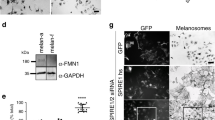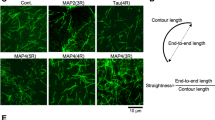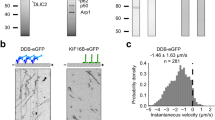Abstract
The microtubule network is thought to be used for long-range transport of cellular components in animal cells whereas the actinnetwork is proposed to be used for short-range transport1, although the mechanism(s) by which this transport is coordinated is poorly understood. For example, in sea urchins long-range Ca2+-regulated transport of exocytotic vesicles requires a microtubule-based motor, whereas an actin-based motor is used for short-range transport2. In neurons, microtubule-based kinesin motor proteins are used for long-range vesicular transport3 but microtubules do not extend into the neuronal termini, where actin filaments form the cytoskeletal framework4, and kinesins are rapidly degraded upon their arrival in neuronal termini5, indicating that vesicles may have to be transferred from microtubules to actin tracks to reach their final destination. Here we show that an actin-based vesicle-transport motor, MyoVA (ref. 6), can interact directly with a microtubule-based transport motor, KhcU. As would be expected if these complexes were functional, they also contain kinesin light chains and the localization of MyoVA and KhcU overlaps in the cell. These results indicate that cellular transport is, in part, coordinated through the direct interaction of different motor molecules.
This is a preview of subscription content, access via your institution
Access options
Subscribe to this journal
Receive 51 print issues and online access
$199.00 per year
only $3.90 per issue
Buy this article
- Purchase on Springer Link
- Instant access to full article PDF
Prices may be subject to local taxes which are calculated during checkout





Similar content being viewed by others
References
Langford, G. M. Actin- and microtubule-dependent organelle motors: interrelationships between the two motility systems. Curr. Opin. Cell Biol. 7, 82–88 (1995).
Bi, G. Q. et al. Kinesin- and myosin-driven steps of vesicle recruitment for Ca2+-regulated exocytosis. J. Cell Biol. 138, 999–1008 (1997).
Brady, S. T. Akinesin medley: biochemical and functional heterogeneity. Trends Cell Biol. 5, 159–164 (1995).
LeBeux, Y. J. & Willemot, J. An ultrastructural study of the microfilaments in rat brain by means of E-PTA staining and heavy meromyosin labeling. II. The synapses. Cell. Tissue Res. 160, 37–68 (1975).
Okada, Y., Yamazaki, H., Sekine-Aizawa, Y. & Hirokawa, N. The neuron-specific kinesin superfamily protein KIF1A is a unique monomeric motor for anterograde axonal transport of synaptic vesicle precursors. Cell 81, 769–780 (1995).
Cheney, R. E. et al. Brain myosin-V is a two-headed unconventional myosin with motor activity. Cell 75, 13–23 (1993).
Dekker-Ohno, K., Oda, S., Yamamura, H. & Kondo, K. An ataxic mutant rat with dilute coat color. Lab. Anim. Sci. 43, 370–372 (1993).
Mercer, J. A., Seperack, P. K., Strobel, M. C., Copeland, N. G. & Jenkins, N. A. Anovel myosin heavy chain encoded by murine dilute coat colour locus. Nature 349, 709–713 (1991).
Provance, D. W., Wei, M., Ipe, V. & Mercer, J. A. Cultured melanocytes from dilute mutant mice exhibit dendritic morphology and altered melanosome distribution. Proc. Natl Acad. Sci. USA 93, 14554–14558 (1996).
Wu, X. F., Bowers, B., Wei, Q., Kocher, B. & Hammer, J. A. Myosin V associates with melanosomes in mouse melanocytes — evidence that myosin V is an organelle motor. J. Cell Sci. 110, 847–859 (1997).
Dekker-Ohno, K. et al. Endoplasmic reticulum is missing in dendritic spines of Purkinje cells of the ataxic mutant rat. Brain Res. 714, 226–230 (1996).
Takagishi, Y. et al. The dilute-lethal (dl) gene attacks a Ca2+ store in the dendritic spine of Purkinje cells in mice. Neurosci. Lett. 215, 169–172 (1996).
Prasad, R. et al. Cloning of the ALL-1 fusion partner, the AF-6 gene, involved in acute myeloid leukemias with the t(6;11) chromosome translocation. Cancer Res. 53, 5624–5628 (1993).
Miyamoto, H. et al. canoe encodes a novel protein containing a GLGF/DHR motif and functions with Notch and scabrous in common developmental pathways in Drosophila. Genes Dev. 9, 612–625 (1995).
Ponting, C. P. AF-6/cno: neither a kinesin nor a myosin, but a bit of both. Trends Biochem. Sci. 20, 265–266 (1995).
Gudkov, A. V. et al. Cloning mammalian genes by expression selection of genetic suppressor elements: association of kinesin with drug resistance and cell immortalization. Proc. Natl Acad. Sci. USA 91, 3744–3748 (1994).
Leopold, P. L., McDowall, A. W., Pfister, K. K., Bloom, G. S. & Brady, S. T. Association of kinesin with characterized membrane-bounded organelles. Cell Motil. Cytoskeleton 23, 19–33 (1992).
Brady, S. T., Pfister, K. K. & Bloom, G. S. Amonoclonal antibody against kinesin inhibits both anterograde and retrograde fast axonal transport in squid axoplasm. Proc. Natl. Acad. Sci. USA 87, 1061–1065 (1990).
Hirokawa, N. et al. Kinesin associates with anterogradely transported membranous organelles in vivo. J. Cell Biol. 114, 295–302 (1991).
Pfister, K. K., Wagner, M. C., Stenoien, D. L., Brady, S. T. & Bloom, G. S. Monoclonal antibodies tokinesin heavy and light chains stain vesicle-like structures, but not microtubules, in cultured cells. J.Cell Biol. 108, 1453–1463 (1989).
Rodionov, V. I., Gyoeva, F. K. & Gelfand, V. I. Kinesin is responsible for centrifugal movement of pigment granules in melanophores. Proc. Natl Acad. Sci. USA 88, 4956–4960 (1991).
Niclas, J., Navone, F., Hom-Booher, N. & Vale, R. D. Cloning and localization of a conventional kinesin motor expressed exclusively in neurons. Neuron 12, 1059–1072 (1994).
Navone, F. et al. Cloning and expression of a human kinesin heavy chain gene: interaction of the COOH-terminal domain with cytoplasmic microtubules in transfected CV-1 cells. J. Cell Biol. 117, 1263–1275 (1992).
Tsan, J. T. et al. in The Yeast Two-Hybrid Systems(eds Bartel, P. L. & Fields, P. S.) 217–232 (Oxford Univ. Press, Oxford, (1997)).
Stenoien, D. S. & Brady, S. T. Immunochemical analysis of kinesin light chain function. Mol. Biol. Cell 8, 675–689 (1997).
Evans, L. L., Hammer, J. & Bridgman, P. C. Subcellular localization of myosin V in nerve growth cones and outgrowth from dilute-lethal neurons. J. Cell Sci. 110, 439–449 (1997).
Prekeris, R. & Terrian, D. M. Brain myosin V is a synaptic vesicle-associated motor protein: evidence for a Ca2+-dependent interaction with the synaptobrevin-synaptophysin complex. J. Cell Biol. 137, 1589–1601 (1997).
Lillie, S. H. & Brown, S. S. Suppression of a myosin defect by a kinesin-related gene. Nature 356, 358–361 (1992).
Lillie, S. H. & Brown, S. S. Immunofluorescence localization of the unconventional myosin, Myo2p, and the putative kinesin-related protein, Smy1p, to the same regions of polarized growth in Saccharomyces cerevisiae. J. Cell Biol. 125, 825–842 (1994).
Seperack, P. K., Mercer, J. A., Strobel, M. C., Copeland, N. G. & Jenkins, N. A. Retroviral sequences located within an intron of the dilute gene alter dilute expression in a tissue-specific manner. EMBO J. 14, 2326–2332 (1995).
Acknowledgements
We thank J. Hammer for the MyoVA antibody DIL-2; S. J. Elledge for the pAS2vector and Y187 yeast strain; S. Hollenberg for the mouse embryonic cDNA library; and R. Frederickson for help with graphics. This work was supported by the National Cancer Institute, DHHS, under contract with ABL, and by a grant to S.T.B. from the National Institute of Neurological Disease and Stroke NINDS, a joint grant from NASA and the National Institute of Aging, and a grant from the Welch Foundation.
Author information
Authors and Affiliations
Corresponding author
Rights and permissions
About this article
Cite this article
Huang, JD., Brady, S., Richards, B. et al. Direct interaction of microtubule- and actin-based transport motors. Nature 397, 267–270 (1999). https://doi.org/10.1038/16722
Received:
Accepted:
Issue Date:
DOI: https://doi.org/10.1038/16722
This article is cited by
-
Cargo specificity, regulation, and therapeutic potential of cytoplasmic dynein
Experimental & Molecular Medicine (2024)
-
AMPK-dependent phosphorylation of cingulin reversibly regulates its binding to actin filaments and microtubules
Scientific Reports (2018)
-
A new role of anterograde motor Kif5b in facilitating large clathrin-coated vesicle mediated endocytosis via regulating clathrin uncoating
Cell Discovery (2018)
-
Segregation of prokaryotic magnetosomes organelles is driven by treadmilling of a dynamic actin-like MamK filament
BMC Biology (2016)
-
Axonal transport deficits and neurodegenerative diseases
Nature Reviews Neuroscience (2013)
Comments
By submitting a comment you agree to abide by our Terms and Community Guidelines. If you find something abusive or that does not comply with our terms or guidelines please flag it as inappropriate.



